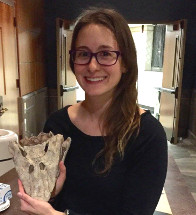
Tag: Jennifer E. Bauer

Jen is an evolutionary palaeobiologist based at the Florida Museum of Natural History in Gainesville. Her research focuses on understanding the evolutionary history and macroevolutionary patterns of fossil echinoderm groups. She spends much of her time in museum collections exploring the morphology of these extinct animals and digitally reconstructing their internal anatomy to include as data points in reconstructing extinct portions of the echinoderm tree of life. To do this, she uses both historical techniques (for example, acetate peels) and advanced ones (such as X-ray computed tomography). She also has a strong interest in providing educators of children from kindergarten to grade 12 with fossils to incorporate into their classrooms and has distributed more than 400 fossil kits to educators. Outside of research, Jen is an avid cyclist, knitter and devoted cat mom.
Contact Details:
Dr. Jennifer E. Bauer, Florida Museum of Natural History, 1659 Museum Road, Gainesville, FL 32611 USA.
